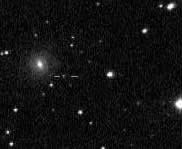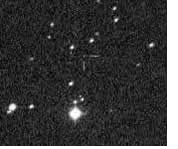On the evening of 30th November 1997 we were obtaining CCD frames for the UKNova/ Supernova patrol using a 10″LX200, operating at f3.3 and StarlightXpress. At 21.30UT we imaged a suspect object near ngc765, a type SBb/Sc, 14th mag spiral galaxy in Aries. Estimating the magnitude at brighter than 16 we initially thought we might have discovered a second supernova as this was rather bright for a new asteroid and no known asteroid was in the region of the galaxy. We used the Sky v4 to control the LX200 and always load the 34000 minor planets before we start patrolling so are forewarned of any asteroid in the field. We also checked Megastar and the new service to check supernova suspects for minor planets at the Central Bureau for Astronomical Telegrams Web site:
A second image 25 minutes later clearly showed movement, ruling out a supernova. Ignoring our chagrin we took a final image at 22.28UT, measured the positions using astrometrica, a commercial astrometry software package and sent a report to Martin Mobberley, deputising for Guy Hurst who was away on business.


The skies remained cloudy until on 3rd December we imaged six overlapping fields twice, approximately one hour apart to try and recover the suspect. At this stage we had to estimate where we thought the suspect should be as we don’t have the software to calculate a rough ephemeris from initial observations. We picked up only one object showing movement and not appearing in the `Real Sky` field but were doubtful that it was the suspect as it appeared at least 0.5 magnitude fainter and CCD images taken near the ecliptic can often reveal faint asteroids. However we measured the new positions and reported to Guy Hurst.
Meanwhile on 2/3 December Stephen Laurie, having seen our original report but unable to respond immediately due to business, imaged an object in the approximate position. Using Computer-Aided Astrometry, another commercial software package, he imputed all the measured positions to date and concluded that they were all the same object!
Guy reported the observations to the Minor Planet Centre on 6th December and the asteroid received the official designation 1997 WQ28. We have now secured 28 observations over a 55 day arc and the object has still not been linked to a previously designated object. Our previous `discovery` 1997 DV was linked to 1990 QN5, discovered at Palomar!
Article originally by Mark Armstrong
